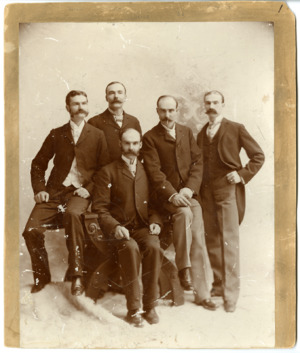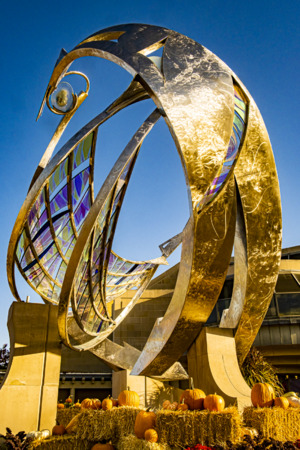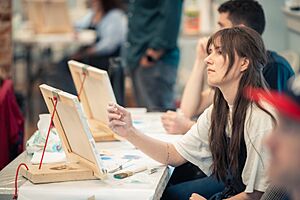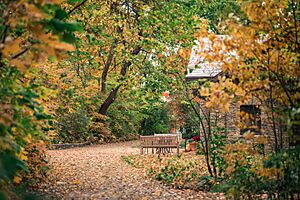- This page was last modified on 17 October 2025, at 10:18. Suggest an edit.
Minnetrista Museum & Gardens facts for kids
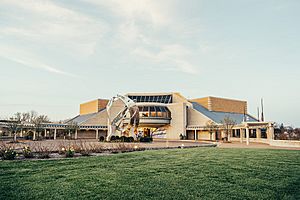 |
|
| Established | 10 December 1988 |
|---|---|
| Location | Muncie, Indiana |
| Public transit access | Muncie Indiana Transit System |
| Nearest parking | On site (no charge) |
Minnetrista Museum & Gardens is a fun place to visit in Muncie, Indiana. It opened in 1988. This special museum and garden covers 40 acres (about 16 hectares) along the White River. It was created to honor the history of the Ball family and their famous company. Minnetrista offers exciting exhibits, peaceful nature trails, educational programs, and community events for everyone.
Contents
Discovering Minnetrista: Location and Name
Minnetrista's large campus sits on a hill overlooking the White River. Today, you can find modern museum buildings and five historic homes from the Gilded Age here. There are also over 20 acres of beautiful gardens. From the 1890s until the 1980s, this land was home to the Ball family. They were famous for inventing the Ball Mason jar, which many people still use today for canning food!
The name "Minnetrista" comes from a Ball family story. It mixes the Sioux (Dakota) word "mna" (meaning water) with the English word "tryst" (meaning a gathering place). So, Minnetrista means "gathering place by the water." While the name has a special meaning to the Ball family, it's important to remember that the Sioux people were not originally from this area. Minnetrista Museum & Gardens now works hard to be a welcoming place for all people in East Central Indiana.
The Land Before the Ball Family
Before Muncie became a city, this land was home to Native American communities. The Potowatomi and Miami lived here for a long time. In the 1700s, part of the Minnetrista site was also home to the Delaware Nation. These groups were later forced to move west, away from their ancestral lands.
The Ball Family and Their Famous Jars
In the mid-1880s, the Ball family decided to move their glass business to Muncie. There was a natural gas boom in the area, which was great for factories. The Ball brothers quickly grew their business. By the early 1900s, they were making canning jars for people all over the world!
Between 1893 and 1907, the five Ball brothers built their family homes next to each other along the White River. Most of these homes are still standing today. The first Frank C. Ball family home, which was originally called Minnetrista, burned down in 1967. Today, Minnetrista Museum & Gardens takes care of three of these historic houses: Oakhurst, the Lucius L. Ball House, and the Mary Lincoln Cottage.
Ball Family Homes at Minnetrista
| House | Ball Brother | Family |
|---|---|---|
| L.L. Ball home | Lucius Lorenzo Ball | Lucius, Sarah, and their daughter Helen |
| Maplewood | William Charles Ball | William, Emma, and their son William |
| Nebosham | Edmund Burke Ball | Edmund, Bertha, and their children Edmund, Clinton, Adelia, Janice |
| Minnetrista (original) | Frank Clayton Ball | Frank, Elizabeth, and their children Arthur, Lucina, Margaret, Frank, Rosemary |
| Oakhurst | George Alexander Ball | George, Frances, and their daughter Elisabeth |
Minnetrista Museum & Gardens Today
In the late 1970s, the Ball family started thinking about opening their property to the public. Elisabeth Ball, the last family member to live there full-time, passed away in 1982. Plans were then made to build a museum where the original Frank C. Ball house once stood. The Minnetrista Cultural Center opened its doors on December 10, 1988. In 2021, its name changed to Minnetrista Museum & Gardens.
Minnetrista is one of several important organizations started by the Ball family. These groups continue to help the community in East Central Indiana. Other "sister" organizations include Ball State University and IU Health Ball Memorial Hospital. You can even see their connections on the Minnetrista campus! For example, Ball State University Foundation now owns and cares for the Nebosham house.
Treasures in the Collection
Minnetrista has a special collection of items that tell the story of the Ball company, the Ball family, and East Central Indiana. This "Heritage Collection" has over 17,000 objects and many historical documents. It includes records from the Ball company, lots of Ball-made products, artwork, old clothes, letters, and photographs. You can even explore some of these items online!
Exciting Exhibitions and Programs
Minnetrista always has new art, history, and family-friendly exhibits. There are also permanent exhibits that share the stories of the Minnetrista site.
- Oakhurst Experience: This exhibit opened in 2019 inside the historic Oakhurst Home. It was once the home of George and Frances Ball and their daughter Elisabeth. The Oakhurst Experience celebrates their love for reading, family, and canning. You can see hundreds of books in the library, which once held one of the world's largest collections of rare children's books. The kitchen shows how food was preserved, with fun activities about canning methods. This is where the famous Ball Blue Book was created!
- Bob Ross Experience: Opened in 2020, this unique exhibit is in the very place where "The Joy of Painting" TV show was filmed! That's right, it's in the Lucius L. Ball home on the Minnetrista campus. The exhibit tells the story of Bob Ross and his connection to Minnetrista. It features a recreated TV studio, a 1980s-style living room, an art gallery, and a painting workshop. You'll see real objects, old photos, original paintings, and interactive displays that explore Bob Ross's art and philosophy.
Fun Programs and Events
Minnetrista offers many community and family programs all year long. These include school tours, painting workshops, and glass-working classes. They also host three big events each year:
- Faeries, Sprites & Lights
- Enchanted Luminaria Walk
- Garden Fair
You can also visit their Farmers Market for fresh local goods.
Beautiful Gardens to Explore
When the Ball family built their homes, they also created amazing gardens. They had beautiful lawns, award-winning rose gardens, fruit orchards, and ornamental gardens. Since the museum opened in 1988, these historic green spaces have been brought back to life. New formal gardens have also been added, inspired by the Ball family's history. These include:
- Oakhurst Gardens
- Orchard Garden
- Culinary Herb Garden
- Rose Garden
- Wishing Well Garden
- Backyard Garden
- The Nature Area
See also
 In Spanish: Centro Cultural Minnetrista para niños
In Spanish: Centro Cultural Minnetrista para niños
- List of botanical gardens and arboretums in Indiana
- List of museums in Indiana

